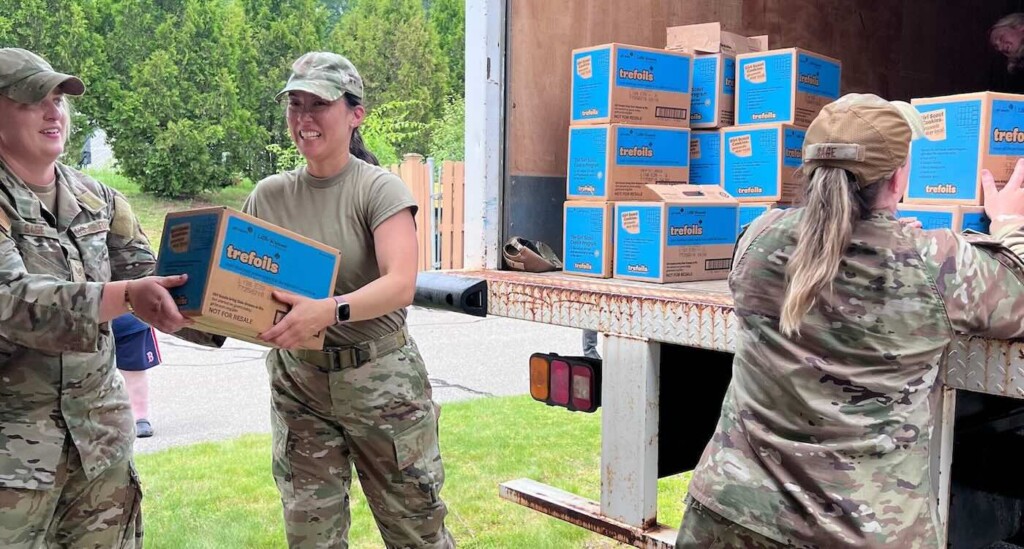They sold 14,000 boxes of cookies 🍪—but this time, not for badges or prizes.
This month in Massachusetts, the Girl Scouts reminded everyone that their famous cookies are about far more than Thin Mints and Samoas — they’re about heart, service, and gratitude.
In a gesture that combined community spirit with a deep sense of appreciation for those serving the nation,
A Mission of Sweet Gratitude

On June 6, a convoy of trucks rolled out of Westfield, Massachusetts, carrying 13,989 boxes — 1,166 cases — of cookies bound for the
For many of those service members, the familiar green and purple boxes will mean more than just a sweet treat — they’ll be a tangible reminder that they’re remembered, appreciated, and supported by the very communities they protect.
The project was powered by the enthusiasm and dedication of 1,771 Girl Scouts across Central and Western Massachusetts, all of whom played a role in making the effort possible. It wasn’t just about selling cookies — it was about connecting purpose to action, and business to kindness.
The Spirit Behind the Sales
Since its creation over a century ago, the Girl Scout Cookie Program has been more than a fundraiser — it’s a foundation for leadership. Girls as young as five learn how to set goals, manage money, and communicate with confidence. But this year, Project Care and Share reminded them that real success also means
“Every scout, every person, can make an impact in their own way,” said Shaylynne Rappazini, a Girl Scout Senior and the region’s top seller for the program.
For Shaylynne and her fellow scouts, the mission was simple but profound: to send comfort and care to those serving far from home. When the girls arrived at the cookie distribution site to help load the trucks, their excitement filled the air. Wearing sashes and smiles, they formed assembly lines to pass the boxes along — each one representing dozens of small acts of generosity from cookie buyers who chose to donate a box rather than take it home.

The scene was one of teamwork, laughter, and pride — a generation of young women learning that leadership is not just about leading others, but about lifting others.
From Cookies to Community
For every box of cookies sold, a portion of proceeds stays within the troop to fund activities, service projects, and local causes. But with Project Care and Share, customers can take that one step further — by purchasing cookies specifically for donation to military personnel and local nonprofits.
It’s a cycle of giving that begins with a small purchase and ends with a big impact.
“The Girl Scout Cookie Program is about so much more than cookies,” said
Lynn’s words underscore what has always set the Girl Scouts apart: their ability to connect everyday actions with larger values. Whether it’s a troop planting a community garden, organizing a food drive, or — in this case — sending thousands of cookie boxes to military bases, the message remains the same:
A Sweet Reminder
For the troops who will soon open those boxes, the gesture goes beyond the flavor of a Thin Mint or the crunch of a Tagalong. It’s the warmth of knowing that a child somewhere thought of them — that families and communities came together in gratitude.
Each cookie box carries not just a snack, but a message: You matter. You’re remembered. You’re appreciated.
For the Girl Scouts, the experience has been a powerful lesson in empathy and action. These girls have learned that leadership isn’t measured in badges or sales totals, but in the impact you make on others.
They’ve learned that a simple act — selling cookies — can turn into a movement of kindness that reaches across states and oceans. And they’ve discovered that even small acts, when done together, can create something extraordinary.
More Than a Cookie
Project Care and Share is more than an annual event; it’s a tradition of compassion passed from one generation of Girl Scouts to the next. Each year, the girls prove that service and business can go hand in hand — that profit can serve purpose.
And as those 14,000 cookie boxes make their way to troops around the world, they carry with them the spirit of the scouts who packed them: grateful, determined, and full of heart.
For anyone who has ever wondered what a group of young girls can do when they work together for something bigger than themselves — this is the answer.
It’s not about cookies. It’s about community. It’s about gratitude.
It’s about showing, in the sweetest way possible, that kindness travels far — sometimes all the way to those who protect it.
One day, Demi Moore looked in the mirror—and didn’t recognize the woman staring back.

In a quiet bathroom, alone and unraveling, Demi Moore sat watching her teeth fall out. It wasn’t a scene from a film. It wasn’t artifice. It was real — a surreal but all-too-human moment of collapse after decades spent in the unforgiving glare of fame. Her body, weakened by addiction. Her spirit, dimmed by years of pain disguised as perfection. It wasn’t the tabloids that finally broke her. It was the silence she kept, pretending nothing ever hurt.
For most of the world, Demi Moore was unshakable. She was the tough-but-vulnerable lead of Ghost, the fearless presence in G.I. Jane, the glamorous star who commanded record-breaking salaries and posed defiantly against Hollywood’s expectations. But the woman behind the roles had been shaped long before by forces far harsher than studio bosses or gossip columns.

Before she became one of Hollywood’s most recognizable faces, Demi came from chaos. Born Demetria Gene Guynes in 1962, her childhood was marked by instability. A father who wasn’t really her father. A mother who took her into bars, who used her daughter’s presence as a way to flirt and secure drinks. Poverty, addiction, broken promises — these weren’t distant shadows. They were the fabric of her earliest years. By fifteen, Demi wasn’t a teenager. She was already a survivor.
Hollywood wasn’t her dreamland so much as her escape hatch. She ran toward it not for glory, but for air. And escape, for a while, looked very much like success. Soap operas gave way to film roles. A whirlwind marriage to musician Freddy Moore gave her a new last name and a ticket into the industry. Then came fame — the kind that didn’t just open doors but redefined them.
By the early ’90s, Demi Moore was at the height of her power. She commanded salaries that rivaled her male counterparts, becoming the highest-paid actress of her time. Her face was on magazine covers. Her films dominated the box office. But the spotlight, though dazzling, sharpened more than it softened. Every move was dissected. Every choice, every risk, was met with a louder judgment than her male peers ever faced.

When she posed nude and pregnant on the cover of Vanity Fair, it should have been celebrated as an act of bold vulnerability, a statement about motherhood and female power. Instead, she was accused of scandalizing the public. When she demanded equal pay for her role in Striptease, she wasn’t hailed as a trailblazer — she was labeled greedy, difficult, arrogant. In an era where women were punished for asking for more, Moore armored up.
And still, the cracks formed.
Her marriage to Bruce Willis — itself a Hollywood spectacle — ended in divorce. Her later marriage to Ashton Kutcher, fifteen years her junior, thrust her into a relentless cycle of headlines. The relationship that once seemed like a fairy tale became a theater of public scrutiny. A miscarriage added another layer of grief. Rumors of infidelity followed. All of it compounded into a spiral: the substances, the collapse, the bathroom floor. Hollywood, true to form, offered no safety net. There was only more judgment, more whispers, more front-page photos designed to reduce her to a cautionary tale.
But Demi Moore’s story didn’t end in that collapse. It pivoted. When she released her memoir, Inside Out, it wasn’t an act of reinvention. It wasn’t a comeback vehicle. It was something riskier: the truth. With brutal honesty, she stripped away the illusions she had carried for decades. She wrote about the ache for love that haunted her, the fear of aging in an industry obsessed with youth, the pressure to be everything to everyone. She wrote about abuse, addiction, betrayal, and the impossible task of pretending to be unbreakable.

The book was not polished. It was raw. And that was its power. Demi wasn’t writing to protect her image. She was writing to reclaim her humanity. For once, she wasn’t the action star, or the glossy cover model, or the target of gossip. She was just Demi — fragile, flawed, enduring.
In telling her story, she redefined it. The image of the woman watching her teeth fall out no longer stood as a moment of shame. It became a symbol of what it costs to keep surviving in silence. And more importantly, it became a turning point — the moment she chose truth over performance, selfhood over survival mode.
Demi Moore didn’t fall from grace. She shed it, piece by piece. She stopped performing strength and began living it. She gave voice to the wounds so many people, especially women, carry quietly. And in doing so, she found a power far greater than the ones handed out by box offices or studio contracts.

Today, she stands not as the untouchable superstar of the 1990s, but as something richer: a woman who has lived through devastation and dared to speak it aloud. Her legacy is no longer just about the films she made, or the barriers she broke in Hollywood salaries. It’s about what it means to survive and still choose honesty.
In the end, Demi Moore’s story isn’t about falling apart. It’s about what happens when you stop hiding the pieces. Because sometimes the bravest thing you can do isn’t holding it together. It’s letting it break, and building something truer from what remains.





